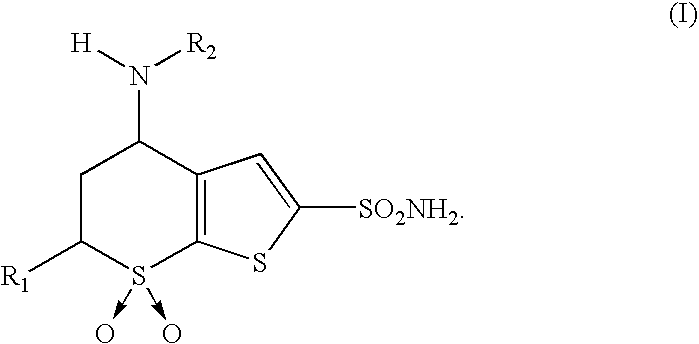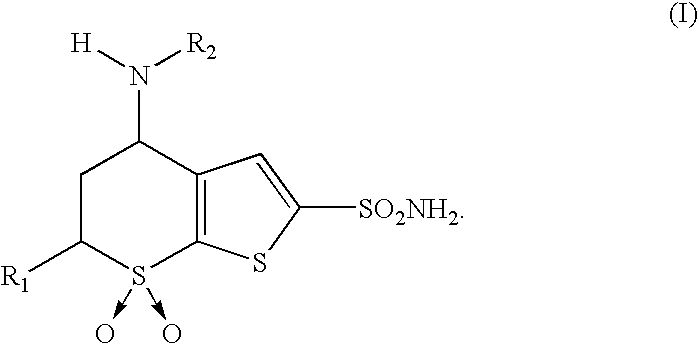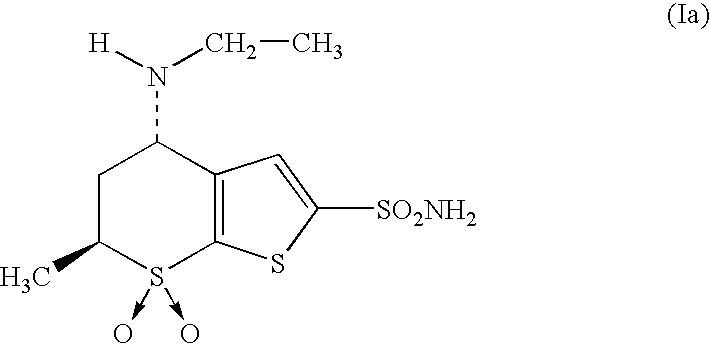Process for obtaining 4-(N-alkylamino)-5,6-dihydro-4H-thien-(2,3-b)-thiopyran-2-sulfonamide-7,7-dioxides and intermediates
a technology of thiopyran and thiopyran, which is applied in the direction of organic chemistry, optically active compound separation, racemisation, etc., can solve the problems of complex final purification process, high cost, and risk of amine nitrogen oxidation, and achieves simple and efficient way
- Summary
- Abstract
- Description
- Claims
- Application Information
AI Technical Summary
Benefits of technology
Problems solved by technology
Method used
Image
Examples
example 1
Trans-4-(N-ethylamino)-5,6-dihydro-6-methyl-4H-thien-(2,3-b)-thiopyran-7,7-dioxide
[0086]
[0087]26 ml (0.2 mol) of 2 M boroetherate trifluoride in a solution of tetrahydrofuran are added to a solution of 4-(N-acetamido)-5,6-dihydro-6-methyl-4H-thien-(2,3-b)-thiopyran-7,7-dioxide (26 g, 0.1 mol) in tetrahydrofuran (320 ml), cooled to between 0 and 5° C. After the addition, the mixture is shaken at room temperature, and sodium borohydride (7.7 g, 0.2 mol) is added. The mixture is kept at room temperature for 1 hour and then poured onto a solution of 4 N hydrochloric acid. It is stirred at room temperature for 1 hour and then the pH is set to 8 with sodium hydroxide. The crude product is extracted three times with ethyl acetate, and the organic extracts are pooled, dried and concentrated to dryness. The crude product is submitted to silica gel chromatography using a mixture THF / Et3N (50 / 3) as solvent, yielding 12 g (49%) of the title product.
[0088]1H NMR (CDCl3, 300 MHz): δ 1.08 (t, 3H),...
example 2
4-(N-isobutylamino)-5,6-dihydro-4H-thien-(2,3-b)-thiopyran-7,7-dioxide
[0089]
[0090]15 ml (0.036 mol) of diborane dimethylsulphide complex in a solution of 2M tetrahydrofuran are added to a solution of 4-(N-isobutyrylamino)-5,6-dihydro-4H-thien-(2,3-b)-thiopyran-7,7-dioxide (5 g, 0.18 mol) in tetrahydrofuran (30 ml), cooled to between 0 and 5° C. After the addition, the mixture is stirred at room temperature for 2 hours. The crude product is neutralised with water and concentrated under vacuum to a thick oil. A solution of 4N hydrochloric acid is added and the mixture kept at room temperature for 1 hour. The pH is set to 8 with sodium hydroxide and the crude extracted three times with ethyl acetate, and the organic extracts are pooled, dried and concentrated to dryness. The crude product is submitted to silica gel chromatography using a mixture CH2Cl2 / MeOH (94 / 6) as solvent, yielding 2.3 g (49%) of the title product.
[0091]1H NMR (CDCl3, 300 MHz): δ 7.46 (d, 1H), 6.92 (d, 1H), 6.84 (d,...
example 3
(4S-trans)-4-(N-ethylamino)-5,6-dihydro-6-methyl-4H-thien-(2,3-b)-thiopyran-7,7-dioxide
Stage A: Preparation of the (−)-Tartaric Salt
[0092]A racemic mixture of trans-4-(N-ethylamino)-5,6-dihydro-6-methyl-4H-thien-(2,3-b)-thiopyran-7,7-dioxide (5 g, 0.022 mol) in isopropanol / water (100 / 2) (100 ml) is heated until it dissolves. While hot, (−)-di-p-tolyl-tartaric acid (3.6 g, 0.01 mol) is added and the mixture allowed to cool slowly. When it has reached room temperature, the resulting solid is filtered to give 4.6 g of salt.
[0093]The solid is suspended once more in 96 ml of the mixture of water and alcohol, and heated under reflux and cooled to room temperature to yield 3.3 g of product. The operation is repeated for a third time, yielding 2.9 g of tartaric salt.
Stage B: Release of the Amine
[0094]The tartaric salt obtained in Stage A is suspended in water and the pH adjusted to 8. The mixture is extracted 3 times with ethyl acetate, and the organic extracts are pooled, dried and concent...
PUM
| Property | Measurement | Unit |
|---|---|---|
| Temperature | aaaaa | aaaaa |
| Temperature | aaaaa | aaaaa |
| Temperature | aaaaa | aaaaa |
Abstract
Description
Claims
Application Information
 Login to View More
Login to View More - R&D
- Intellectual Property
- Life Sciences
- Materials
- Tech Scout
- Unparalleled Data Quality
- Higher Quality Content
- 60% Fewer Hallucinations
Browse by: Latest US Patents, China's latest patents, Technical Efficacy Thesaurus, Application Domain, Technology Topic, Popular Technical Reports.
© 2025 PatSnap. All rights reserved.Legal|Privacy policy|Modern Slavery Act Transparency Statement|Sitemap|About US| Contact US: help@patsnap.com



